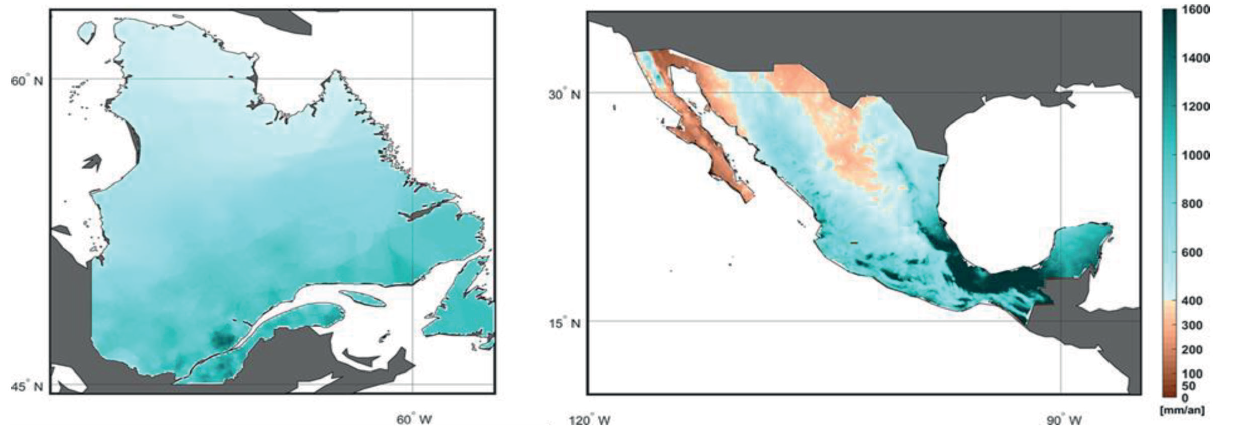Québec-Mexico Complementarity and Diversity Concerning Water Management in the Context of Climate Change
The exchanges and comparisons between Québec and Mexico will make it possible to conduct a comparative analysis in order to enrich the practices and tools for integrated water management adaptation available to Québec users.
Project details
Principal(s) investigator(s)

Context
The project is a reflection of the Government of Quebec’s desire to strengthen scientific ties with Mexico and is based on collaborative scientific research initiated in 2010 between École de technologie supérieure de Montréal (ÉTS) and Universidad Veracruzana (state of Veracruz, Mexico), notably through projects carried out by professors Annie Poulin, Mathias Glaus and Rabindranarth Romero López.
Interest in collaboration stems from the diversity of territorial contexts between Quebec and Mexico that manifests itself in both the climate and geography, in addition to the vulnerability of communities with regard to water resources and the knowledge required to identify adaptation measures.
Based on a holistic approach, there is an interest in addressing aspects associated with hydroclimate modelling and the needs of users who are initiating adaptation efforts.
Objective(s)
-
Acquire new knowledge on hydrological extremes;
-
Establish a structure to analyze the exchange of hydroclimate information and develop an adaptation measure planning tool.
Methodology
Axis 1:
-
Develop modelling approaches that take into account the main sources of uncertainty in flooding forecasts and that aim to improve the level of confidence in such forecasts;
-
Study the added value of hydrological modelling at a sub-daily scale;
-
Study the uncertainty in potential evapotranspiration formulas in baseflow modelling.
Axis 2:
-
Develop information exchange network based on an approach inspired from the analysis of sociological networks and comparison of the reality of the two regions;
-
Develop a matrix structure for territorial sensitivity analysis in order to support the identification of adaptation measures: study of Quebec and Mexico regions.
Results
Taking advantage of the territorial and hydroclimate differences between Québec and Mexico (Figure 1), the first axis of the project led to:
-
The development of strategies for defining and validating hydrological models in contrasting climate conditions, with a focus on seasonal flood modelling;
-
The development of methods to aggregate climate and hydrological simulations with the goal of reducing uncertainty in seasonal flood projections;
-
Analysis of the added value of available data and of hydrological seasonal flood modelling at a sub-daily scale in reactive watersheds;
-
The identification of the extent of uncertainty arising from hydrological model/evapotranspiration formula interaction in studies on climate change impacts on low flows.

Figure 1 - Hydroclimatic diversity between Quebec and Mexico and within Mexican territory (Mean annual total precipitation (mm water eq./year))
According to the results of the second project axis, the information available for understanding adaptation processed is similar in the two regions (mostly in the form of reports) although, for Québec, this information appears to be more specifically geared towards a sub-national/national level (municipalities/province) as opposed to the federal and State level in Mexico. For regional actors who are working on identifying adaptation measures, the information provides an understanding of the main issues and impacts associated with hydroclimate hazards.
Nevertheless, specific collaboration with a community in Québec has shown that the identification of measures adapted to local specificities requires information at a finer spatial resolution and an approach that characterizes the relationship between the hazard (cause) and territorial elements (structures and service infrastructures).
This observation led to the development of a tool to analyze territorial sensitivity to hydroclimate hazards. The tool was applied to municipalities in the St-Régis River watershed in Québec with the help of the Rés-Alliance community of practice, a pilot project of ROBVQ. It has also been adapted and applied in two Mexican municipalities.
Retombées pour l'adaptation
In Quebec, the project has helped strengthen ties between the research team, SCABIRC (St-Régis River watershed organization) and ROBVQ (Thrust II).
Collaborative projects are ongoing, addressing specific issues related to climate change adaptation as it pertains to water management. These projects make use of methodological approaches that are generic in scope and offer the potential for specific applications in Mexico. Once finalized, they will be discussed with Mexican partners.
Consolidation of Quebec-Mexico network of collaborators interested in hydroclimate modelling issues, which will notably culminate in a signed agreement between ETS and IMTA that seeks to promote mobility between the two institutions and the development of research and training projects that address shared challenges in the two regions.
Significant benefits in terms of training of highly qualified staff from Quebec and Mexico.
Scientific publications
Funding

Other participants
-
Université de Veracruz
-
Ministère Environnement et Lutte aux Changements climatiques (MELCC)
-
Regroupement des organismes de bassins versants du Québec (ROBVQ)
-
Institut mexicain des technologies de l'eau (IMTA)
-
Commission nationale de l’eau du Mexique (CONAGUA)